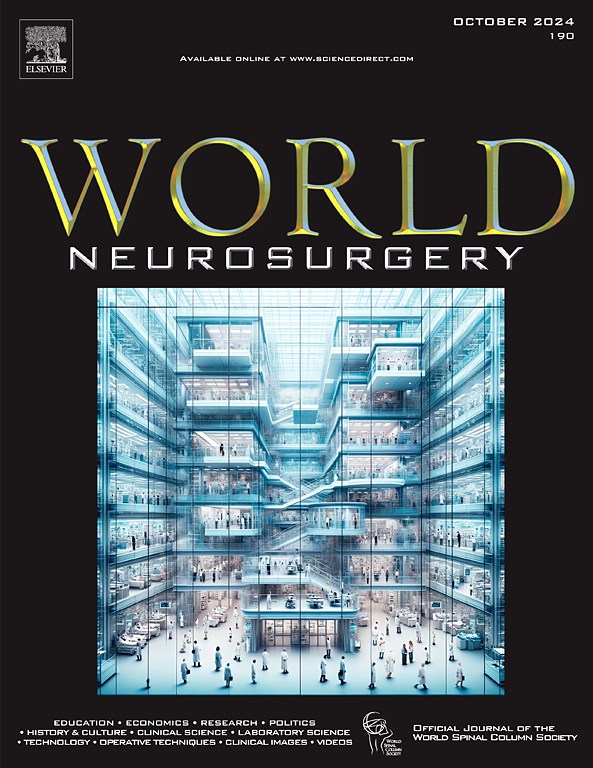眶颧入路和经下颌入路进入颞下窝的比较。
IF 2.1
4区 医学
Q3 CLINICAL NEUROLOGY
引用次数: 0
摘要
引言:颞下窝(ITF)是一个复杂的解剖区域,在颅底手术中具有重要的相关性,特别是由于它涉及肿瘤病变的扩展。手术进入该区域的技术要求仍然很高。眶颧(OZ)和经下颌(TM)入路提供了不同的解剖视角和手术通道。本研究的目的是解剖比较这两种技术,以描绘他们的显微手术领域,优势和局限性进入ITF。材料和方法:使用手术显微镜(放大倍数从×6到×40)解剖共5个注射硅树脂、福尔马林固定的尸体头部(10侧)。进行标准OZ开颅术,随后逐步钻孔中颅窝和切除大蝶翼以暴露ITF。随后,在相同的尸体上进行TM方法以评估其增加的暴露。解剖标志、神经血管结构和空间关系被仔细记录和比较。结果:OZ入路可以广泛暴露ITF的前部和中部,特别是通过前外侧三角形和中窝的孔,并且最小的脑回缩。然而,进入后ITF,上颌动脉和下颅神经是有限的。相反,TM入路提供了中后方ITF的扩展可视化,对上颌动脉的优越控制,并暴露了深层神经血管结构,包括颈内动脉和颅神经IX-XII。两种方法的结合提供了一个互补的创新科技基金全景视图。结论:对于眼眶或海绵状窦扩张的ITF前中段病变,OZ入路是最佳的,而对于需要更宽血管和神经通路的ITF后路病变,TM入路更有效。结合这两种策略可以为涉及ITF的复杂颅底手术提供量身定制的方法。本文章由计算机程序翻译,如有差异,请以英文原文为准。
Comparison of the Orbitozygomatic and Transmandibular Approaches to the Infratemporal Fossa
Objective
The infratemporal fossa (ITF) represents a complex anatomical region of critical relevance in skull base surgery, particularly due to its involvement in the extension of neoplastic lesions. Surgical access to this region remains technically demanding. The orbitozygomatic (OZ) and transmandibular (TM) approaches offer distinct anatomical perspectives and operative corridors. This study aimed to anatomically compare these two techniques to delineate their microsurgical fields, advantages, and limitations in accessing the ITF.
Material and Methods
A total of five silicone-injected, formalin-fixed cadaveric heads (10 sides) were dissected using surgical microscopes at magnifications ranging from ×6 to ×40. A standard OZ craniotomy was performed, followed by progressive drilling of the middle cranial fossa and resection of the greater sphenoid wing to expose the ITF. Subsequently, the TM approach was performed on the same cadavers to evaluate its added exposure. Anatomical landmarks, neurovascular structures, and spatial relationships were meticulously documented and compared across approaches.
Results
The OZ approach enabled wide exposure of the anterior and middle ITF, particularly through the anterolateral triangle and foramina of the middle fossa with minimal brain retraction. However, access to the posterior ITF, maxillary artery, and lower cranial nerves was limited. The TM approach, conversely, provided extended visualization of the middle and posterior ITF, superior control of the maxillary artery, and exposure of deep neurovascular structures, including the internal carotid artery and cranial nerves IX–XII. Integration of both approaches offered a complementary panoramic view of the ITF.
Conclusions
The OZ approach is optimal for anterior and middle ITF lesions with orbital or cavernous sinus extension, while the TM approach is more effective for posterior ITF pathologies requiring wider vascular and neural access. Combining both strategies may offer a tailored approach for complex skull base surgeries involving the ITF.
求助全文
通过发布文献求助,成功后即可免费获取论文全文。
去求助
来源期刊

World neurosurgery
CLINICAL NEUROLOGY-SURGERY
CiteScore
3.90
自引率
15.00%
发文量
1765
审稿时长
47 days
期刊介绍:
World Neurosurgery has an open access mirror journal World Neurosurgery: X, sharing the same aims and scope, editorial team, submission system and rigorous peer review.
The journal''s mission is to:
-To provide a first-class international forum and a 2-way conduit for dialogue that is relevant to neurosurgeons and providers who care for neurosurgery patients. The categories of the exchanged information include clinical and basic science, as well as global information that provide social, political, educational, economic, cultural or societal insights and knowledge that are of significance and relevance to worldwide neurosurgery patient care.
-To act as a primary intellectual catalyst for the stimulation of creativity, the creation of new knowledge, and the enhancement of quality neurosurgical care worldwide.
-To provide a forum for communication that enriches the lives of all neurosurgeons and their colleagues; and, in so doing, enriches the lives of their patients.
Topics to be addressed in World Neurosurgery include: EDUCATION, ECONOMICS, RESEARCH, POLITICS, HISTORY, CULTURE, CLINICAL SCIENCE, LABORATORY SCIENCE, TECHNOLOGY, OPERATIVE TECHNIQUES, CLINICAL IMAGES, VIDEOS
 求助内容:
求助内容: 应助结果提醒方式:
应助结果提醒方式:


